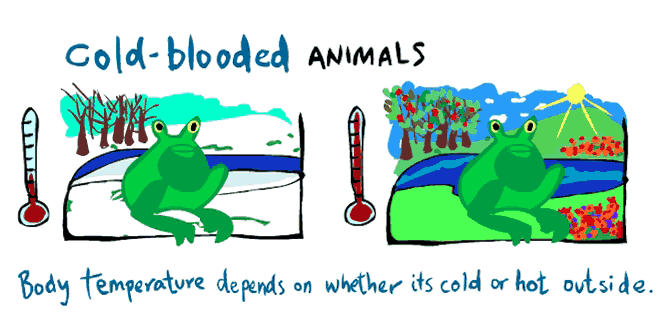Some creatures are cold blooded, which means that the body temperature varies according to the animals surrounding. This means that animals which are cold blooded have to live in certain areas suitable for their survival. This is one reason why you never find cold blooded creatures living in very cold surrounding like polar regions they would die of cold because they would not be able to maintain a body temperature suitable for life. Fish are cold blooded, so are amphibians and reptiles.
Key Differences (Cold vs Warm blooded animals)
Basis for Comparison |
Cold |
Warm |
| Definition | Cold-blooded animals are the animals that are not capable of regulating their body’s temperature according to the temperature of the surrounding. | Warm-blooded animals are the animals that are capable of maintaining a nearly constant body temperature irrespective of the temperature of the environment. |
| Also known as | Cold-blooded animals are also known as poikilothermic animals. | Warm-blooded animals are also known as homeothermic animals. |
| Types | Cold-blooded mechanisms can be broadly categorized as;
1. Ectothermy 2. Poikilothermy 3. Homeothermy |
Warm-blooded animals are classified into broad areas as;
1. Endothermy 2. Homeothermy |
| Body temperature | They do not have specific body temperature as their body changes its temperature according to the surrounding temperature. | Usually, their body temperature remains constant and ranges from 35-40°C. |
| Metabolic rates | Metabolic rates of such animals depend entirely on the environmental temperature. | In these animals, environmental changes have no effect on metabolic rates. |
| Phase | They undergo two phases to be protected from extreme climate. Hibernation is a resting phase in winter that may extend from weeks to months. Aestivation, which is a resting phase in summer. | They do not undergo any such phases as they can adapt to the changing environmental temperature. |
| Organ system | Poikilotherms do not have high-energy organ systems like the brain. | Warm-blooded animals have complex organ systems. |
| Heat regulation | These animals tend to regulate the heat in their body by activities such as stretching out limbs under sunlight, changing body colors, bathing in the sun, etc. | Warm-blooded animals perform many varied activities to regulate the body heat that includes metabolic activities and adaptive activities such as sweating, panting, migration, changing the body surface area to body volume ratio, etc. |
| Resistance against microorganism | Cold-blooded animals have resistance against microorganisms, and when they are infected, they reduce body temperature as a defense mechanism. | Warm-blooded animals have a much stronger immune system to defend against such microorganisms. |
| Energy production | They gain energy in the form of heat to regulate body temperature for survival. | They can easily produce heat within their body. |
| Survival | Such animals cannot survive in any extreme temperature and conditions. | These animals quickly adapt themselves to any environmental conditions and temperature. |
| Heat source | They mostly depend upon direct sunlight and heat from the surrounding environment. | They produce heat from the consumption of foods. |
| Proteins | Cold-blooded animals have multiple proteins, each of which performs at different temperatures. | The proteins in warm-blooded animals are not temperature-specific. |
| Genome | The genome in some cold-blooded animals might be more complex. | The genome in most warm-blooded animals has simpler complexity. |
| Effect of body fats | Excessive fat causes overheating of the bodies of these animals and might even lead to death. | Fat is essential for these animals as it helps maintain body heat, especially for animals like seals and whales, which live in freezing oceans. |
| Examples | Animals like invertebrates, fishes, sharks, frogs, crocodiles, etc are some examples of cold-blooded animals. | Birds and mammals are examples of warm-blooded animals. |
 Kids Portal For Parents India Kids Network
Kids Portal For Parents India Kids Network







